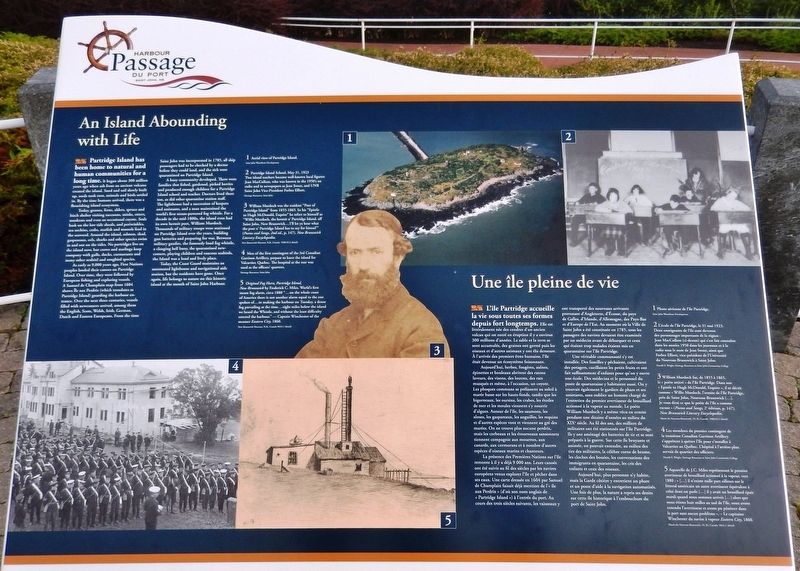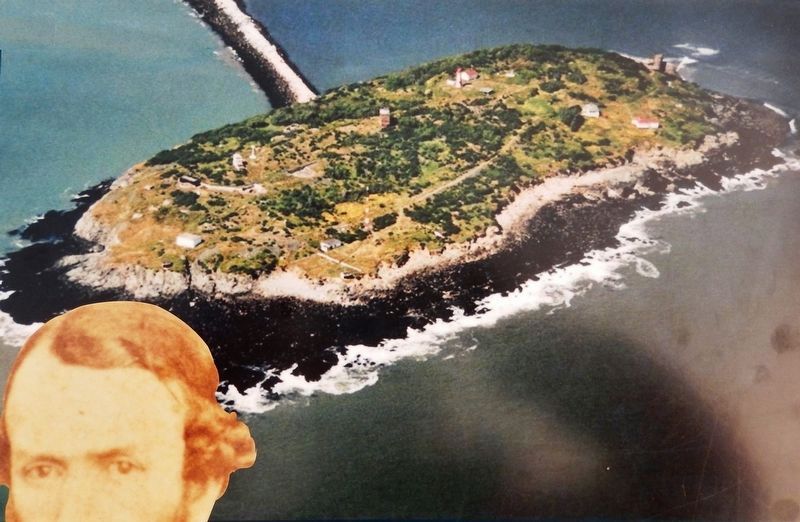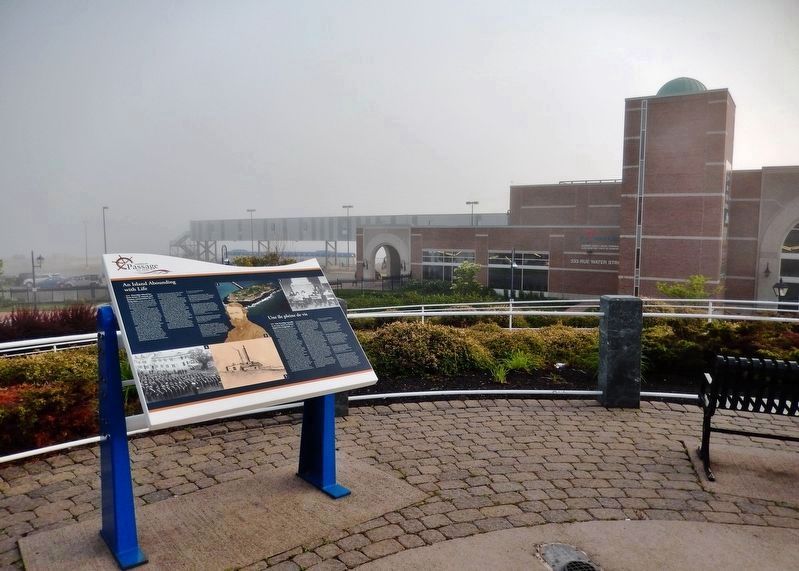Saint John in Saint John County, New Brunswick — The Atlantic Provinces (North America)
An Island Abounding With Life
Une île pleine de vie
— Harbour Passage Trail —
Partridge Island has been home to natural and human communities for a long time.
It began about 300 million years ago when ash from an ancient volcano created the island. Sand and soil slowly built up, seeds took root, animals and birds settled in. By the time humans arrived, there was a flourishing island ecosystem.
Today, grasses, ferns, alders, spruce and birch shelter visiting raccoons, minks, otters, muskrats and even an occasional coyote. Seals bask on the low tide shoals, and periwinkles, sea urchins, crabs, starfish and mussels feed in the seaweed. Around the island, salmon, shad, gaspereaux, eels, sharks and other species swim in and out on the tides. No partridges live on the island now, but crows and starlings keep company with gulls, ducks, cormorants and many other seabird and songbird species.
As early as 9,000 years ago, First Nations peoples landed their canoes on Partridge Island. Over time, they were followed by European fishing and exploring vessels. A Samuel de Champlain map from 1604 shows Île aux Perdrix (which translates as Partridge Island) guarding the harbour entrance. Over the next three centuries, vessels filled with newcomers arrived, among them the English, Scots, Welsh, Irish, German, Dutch and Eastern Europeans. From the time Saint John was incorporated in 1785, all ship passengers had to be checked by a doctor before they could land, and the sick were quarantined on Partridge Island.
A busy community developed. There were families that fished, gardened, picked berries and produced enough children for a Partridge Island school and teacher. Doctors lived there too, as did other quarantine station staff. The lighthouse had a succession of keepers and assistants, and a man maintained the world's first steam-powered fog whistle. For a decade in the mid-1800s, the island even had its own hermit poet, William Murdoch. Thousands of military troops were stationed on Partridge Island over the years, building gun batteries and preparing for war. Between military gunfire, the famously loud fog whistle, a clanging bell buoy, the quarantined new-comers, playing children and raucous seabirds, the Island was a loud and lively place.
Today, the Coast Guard maintains an automated lighthouse and navigational aids station, but the residents have gone. Once again, life belongs to nature on this historic island at the mouth of Saint John Harbour.
L'île Partridge accueille la
vie sous toutes ses formes depuis fort longtemps.
Elle est littéralement née des cendres d'un ancien volcan qui est entré en éruption il y a environ 300 millions d'années. Le sable et la terre se sont accumulés, des graines ont germé puis les oiseaux et d'autres animaux y ont élu demeure. À l'arrivée des premiers êtres humains, l'île était devenue un écosystème foisonnant.
Aujourd'hui, herbes, fougères, aulnes, épinettes et bouleaux abritent des ratons laveurs, des visons, des loutres, des rats musqués et même, à l'occasion, un coyote. Les phoques communs se prélassent au soleil à marée basse sur les hauts-fonds, tandis que les bigorneaux, les oursins, les crabes, les étoiles de mer et les moules viennent s'y nourrir d'algues. Autour de l'île, les saumons, les aloses, les gaspareaux, les anguilles, les requins et d'autres espèces vont et viennent au gré des marées. On ne trouve plus aucune perdrix, mais les corbeaux et les étourneaux sansonnets tiennent compagnie aux mouettes, aux canards, aux cormorans et à nombre d'autres espèces d'oiseaux marins et chanteurs.
La présence des Premières Nations sur l'île remonte à il y a déjà 9 000 ans. Leurs canoés ont été suivis au fil des siècles par les navires européens venus explorer l'île et pêcher dans ses eaux. Une carte dressée en 1604 par Samuel de Champlain faisait déjà mention de l'« île aux Perdrix
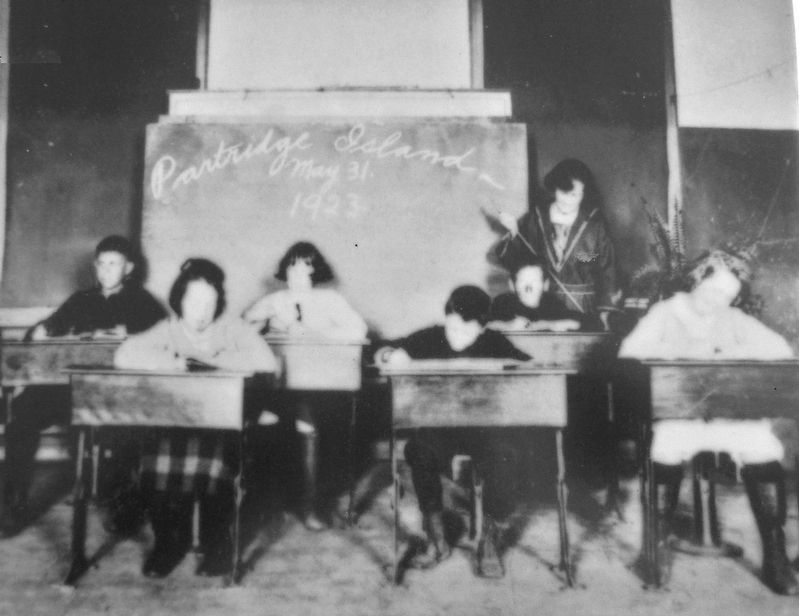
Photographed By Harold E. Wright, Heritage Resources & Saint John Community College
3. Marker detail: Partridge Island School, May 31, 1923
English:
Partridge Island School, May 31, 1923. Two island teachers became well-known local figures: Jean MacCullam, who was known in the 1950's on radio and in newspapers as Jean Sweet, and UNB Saint John Vice-President Forbes Elliott.
Français:
L'école de l'île Partridge, le 31 mai 1923. Deux enseignants de l'île sont devenus des personnages importants de la région : Jean MacCullam (ci-dessus) qui s'est fait connaître dans les années 1950 dans les journaux et à la radio sous le nom de Jean Sweet, ainsi que Forbes Elliott, vice-président de l'Université du Nouveau-Brunswick à Saint John.
Partridge Island School, May 31, 1923. Two island teachers became well-known local figures: Jean MacCullam, who was known in the 1950's on radio and in newspapers as Jean Sweet, and UNB Saint John Vice-President Forbes Elliott.
Français:
L'école de l'île Partridge, le 31 mai 1923. Deux enseignants de l'île sont devenus des personnages importants de la région : Jean MacCullam (ci-dessus) qui s'est fait connaître dans les années 1950 dans les journaux et à la radio sous le nom de Jean Sweet, ainsi que Forbes Elliott, vice-président de l'Université du Nouveau-Brunswick à Saint John.
Une véritable communauté s'y est installée. Des familles y pêchaient, cultivaient des potagers, cueillaient les petits fruits et ont fait suffisamment d'enfants pour qu'on y ouvre une école. Des médecins et le personnel du poste de quarantaine y habitaient aussi. On y trouvait également le gardien de phare et ses assistants, sans oublier un homme chargé de l'entretien du premier avertisseur de brouillard actionné à la vapeur au monde. Le poète William Murdoch y a même vécu en ermite pendant une dizaine d'années au milieu du XIXe siècle. Au fil des ans, des milliers de militaires ont été stationnés sur l'île Partridge. Ils y ont aménagé des batteries de tir et se sont préparés à la guerre. Sur cette île bruyante et animée, on pouvait entendre, au milieu des tirs des militaires, la célèbre corne de brume, les cloches des bouées, les conversations des immigrants en quarantaine,
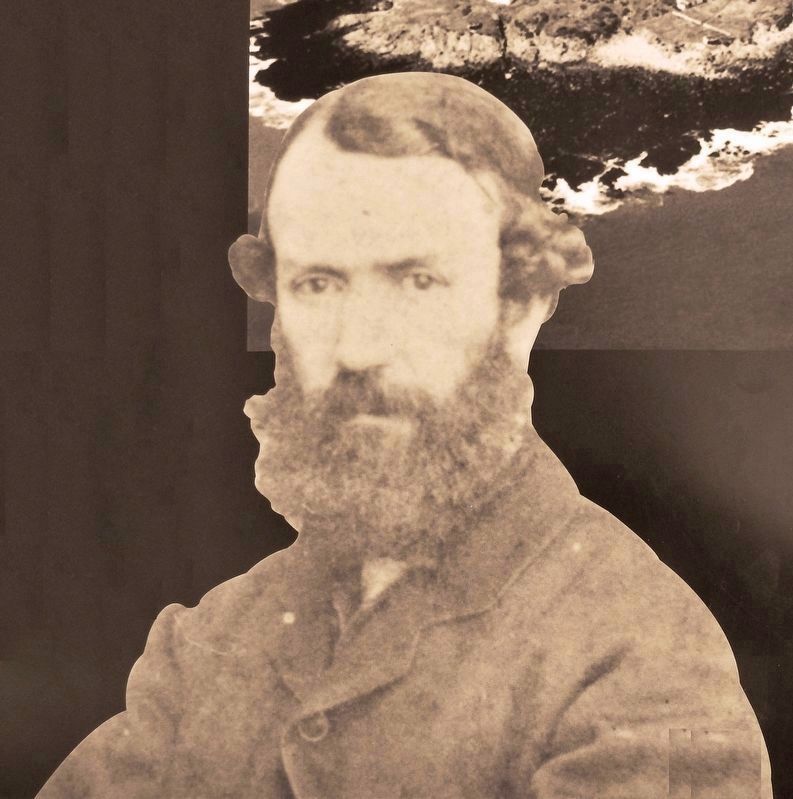
Courtesy New Brunswick Museum, N.B., Canada 1988.93.2 (detail)
4. Marker detail: William Murdoch
English:
William Murdoch was the resident "Poet of Partridge Island" from 1855-1865. In his "Epistle to Hugh McDonald, Esquire" he refers to himself as "Willie Murdoch, the hermit o' Partridge Island, aff Saint John, New Brunswick... I'll let ye hear what the poet o' Partridge Island has to say for himsel'" (Poems and Songs, 2nd ed., p. 147). New Brunswick Literary Encyclopedia.
Français:
William Murdoch fut, de 1855 à 1865, le « poète attitré » de l'île Partridge. Dans son « Epistle to Hugh McDonald, Esquire », il se décrit comme « Willie Murdoch, l'ermite de l'île Partridge, près de Saint John, Nouveau-Brunswick [...]. Je vous dirai ce que le poète de l'île a comme excuse » (Poems and Songs, 2e édition, p. 147). New Brunswick Literary Encyclopedia.
William Murdoch was the resident "Poet of Partridge Island" from 1855-1865. In his "Epistle to Hugh McDonald, Esquire" he refers to himself as "Willie Murdoch, the hermit o' Partridge Island, aff Saint John, New Brunswick... I'll let ye hear what the poet o' Partridge Island has to say for himsel'" (Poems and Songs, 2nd ed., p. 147). New Brunswick Literary Encyclopedia.
Français:
William Murdoch fut, de 1855 à 1865, le « poète attitré » de l'île Partridge. Dans son « Epistle to Hugh McDonald, Esquire », il se décrit comme « Willie Murdoch, l'ermite de l'île Partridge, près de Saint John, Nouveau-Brunswick [...]. Je vous dirai ce que le poète de l'île a comme excuse » (Poems and Songs, 2e édition, p. 147). New Brunswick Literary Encyclopedia.
Aujourd'hui, plus personne n'y habite, mais la Garde côtière y entretient un phare et un poste d'aide à la navigation automatisés. Une fois de plus, la nature a repris ses droits sur cette île historique à l'embouchure du port de Saint John.
Topics. This historical marker is listed in these topic lists: Arts, Letters, Music • Native Americans • Settlements & Settlers • Waterways & Vessels.
Location. 45° 16.029′ N, 66° 3.626′ W. Marker is in Saint John, New Brunswick, in Saint John County. Marker is at the intersection of Prince William Street and Saint James Street, on the left when traveling north on Prince William Street. Marker is located along the walkway, beside the Three Sisters Lamp, overlooking the Diamond Jubilee Cruise Terminal. Touch for map. Marker is in this post office area: Saint John NB E2L 0C5, Canada. Touch for directions.
Other nearby markers. At least 8 other markers are within walking distance of this marker. The "Three Lamps" (here, next to this marker); Shedding Light on the Three Sisters Mystery (here, next to this marker); A Portal to the New World (within shouting distance of this marker); Irish Immigrant Memorial (within shouting distance of this marker); The Marco Polo / Le Marco Polo (within shouting distance of this marker); The Largest in British North America
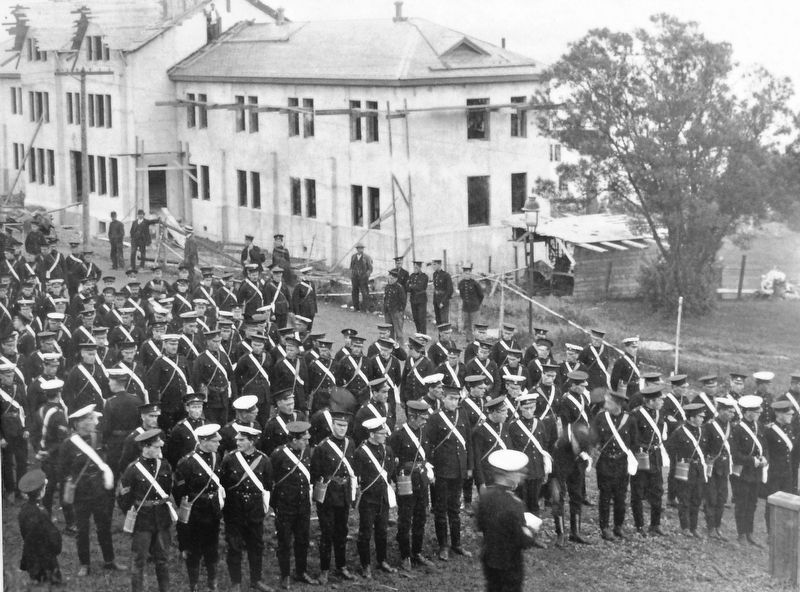
Photographed By Harold E. Wright, Heritage Resources & Saint John Community College
5. Marker detail: 3rd Canadian Garrison Artillery
English:
Men of the first contingent of the 3rd Canadian Garrison Artillery, prepare to leave the island for Valcartier, Quebec. The hospital at the rear was used as the officers' quarters.
Français:
Les membres du premier contingent de la troisième Canadian Garrison Artillery s'apprêtent à quitter l'île pour s'installer à Valcartier au Québec. L'hôpital à l'arrière-plan servait de quartier des officiers.
Men of the first contingent of the 3rd Canadian Garrison Artillery, prepare to leave the island for Valcartier, Quebec. The hospital at the rear was used as the officers' quarters.
Français:
Les membres du premier contingent de la troisième Canadian Garrison Artillery s'apprêtent à quitter l'île pour s'installer à Valcartier au Québec. L'hôpital à l'arrière-plan servait de quartier des officiers.
Also see . . .
1. Canadian Inventions –The Steam Fog-horn. Deeth Williams Wall website entry:
Robert Foulis, a transplanted Scot intending to travel to Ohio, was diverted to the Canadian Maritime provinces by poor weather in 1818, prompting him to settle first in Halifax and then in Saint John. Although lighthouses were of great benefit to mariners, they were naturally of no help whatever during bad weather conditions, whereas coded sound signals from the deep notes of a fog-horn could warn of the presence of rocks, even from a great distance. In 1853, Foulis presented his plans to the Lighthouse Commissioners of the New Brunswick Provincial Assembly for a steam fog-horn in Saint John Harbour. Delays ensued, but finally, in 1859 Foulis’ fog-horn was installed – the first such installation anywhere in the world. (Submitted on February 21, 2020, by Cosmos Mariner of Cape Canaveral, Florida.)
2. Partridge Island Lighthouse. Lighthouse Friends website entry (Submitted on June 5, 2023, by Larry Gertner of New York, New York.)
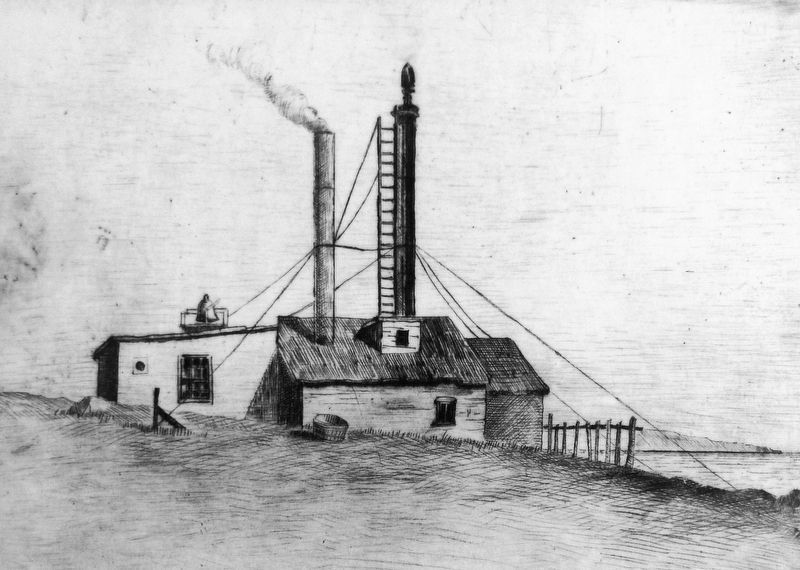
Courtesy New Brunswick Museum, N.B., Canada 9833.1 (detail)
6. Marker detail: World's first steam fog alarm, circa 1880
English:
Original Fog Horn, Partridge Island, New Brunswick
by Frederick C. Miles.
World's first steam fog alarm, circa 1880.
"...on the whole coast of America there is not another alarm equal to the one spoken of... in making the harbour on Tuesday, a dense fog prevailing at the time... eight miles below the island we heard the Whistle, and without the least difficulty entered the harbour."
— Captain Winchester of the steamer Eastern City, 1860.
Français:
Aquarelle de J.C. Miles représentant le premier avertisseur de brouillard actionné à la vapeur, vers 1880.
« [...] il n'existe nulle part ailleurs sur le littoral américain un autre avertisseur équivalent à celui dont on parle [...] il y avait un brouillard épais mardi quand nous sommes arrivés [...] alors que nous étions huit milles au sud de l'île, nous avons entendu l'avertisseur et avons pu pénétrer dans le port sans aucun problème ».
— Le capitaine Winchester du navire à vapeur Eastern City, 1860.
Original Fog Horn, Partridge Island, New Brunswick
by Frederick C. Miles.
World's first steam fog alarm, circa 1880.
"...on the whole coast of America there is not another alarm equal to the one spoken of... in making the harbour on Tuesday, a dense fog prevailing at the time... eight miles below the island we heard the Whistle, and without the least difficulty entered the harbour."
— Captain Winchester of the steamer Eastern City, 1860.
Français:
Aquarelle de J.C. Miles représentant le premier avertisseur de brouillard actionné à la vapeur, vers 1880.
« [...] il n'existe nulle part ailleurs sur le littoral américain un autre avertisseur équivalent à celui dont on parle [...] il y avait un brouillard épais mardi quand nous sommes arrivés [...] alors que nous étions huit milles au sud de l'île, nous avons entendu l'avertisseur et avons pu pénétrer dans le port sans aucun problème ».
— Le capitaine Winchester du navire à vapeur Eastern City, 1860.
Credits. This page was last revised on June 5, 2023. It was originally submitted on February 18, 2020, by Cosmos Mariner of Cape Canaveral, Florida. This page has been viewed 118 times since then and 4 times this year. Photos: 1. submitted on February 20, 2020, by Cosmos Mariner of Cape Canaveral, Florida. 2, 3, 4, 5, 6, 7. submitted on February 21, 2020, by Cosmos Mariner of Cape Canaveral, Florida.
